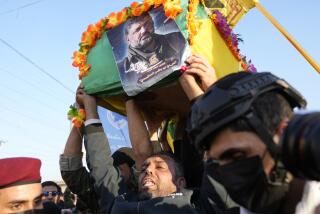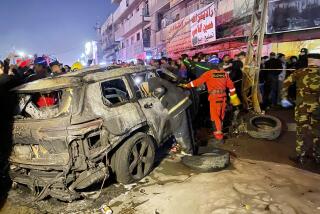U.S. surprised by Islamic State’s rapid growth

As Islamic State fighters from Syria blitzed across northern Iraq this summer, they swept thousands of fresh recruits from Iraqi Sunni tribal militias, prisons and insurgent groups into their ranks, nearly tripling the size of their armed force and catching U.S. authorities by surprise, U.S. intelligence officials said Friday.
Dismantling the lethal new alliances in Iraq will be a key focus as the Obama administration scrambles to push back the fast-growing extremist army, which has achieved major military gains, shows sophisticated command and control, and is exceedingly well-funded, the intelligence officials said.
In coming days, the U.S. military “will be more aggressive and shift a focus from what has been, to date, primarily defensive in nature to offensive in nature,” said Rear Adm. John Kirby, the Pentagon press secretary.
The still-emerging strategy calls for peeling away the Sunni Arab militias with cash payments and other overtures from the still-forming government in Baghdad, including creation of new local defense units in Sunni towns and villages and an increase in U.S. bombing to support Iraqi and Kurdish ground troops. Airstrikes also will target Islamic State leaders for the first time, the officials said.
The campaign will reprise many of the tactics that helped defang Islamic State’s precursor group, Al Qaeda in Iraq, after its deadly car bombs and brutal executions sparked a violent backlash by other Sunni Muslims and led to its decline after 2007 in what was dubbed the Sunni Awakening.
Unlike that now-defunct group, Islamic State effectively controls much of the Tigris-Euphrates basin, an area the size of Britain, with little interference until now. In addition to freedom of movement, U.S. officials say the heavily armed group takes in as much as $1 million a day from illicit oil sales, smuggling and ransom payments.
“The problem now is that ISIS looks like it is winning,” said a U.S. intelligence official, one of several who asked for anonymity to discuss internal assessments. He was using one of several acronyms for Islamic State. “We have to change that,” he added.
Islamic State can muster 20,000 to 31,500 fighters across eastern Syria and northwestern Iraq, according to a new assessment by the CIA, up from an estimated 10,000 earlier this year. The roster includes an estimated 2,000 foreign fighters, hundreds of them Europeans and about a dozen of them U.S. citizens.
Most of the new fighters are unemployed, disaffected Sunnis who have been battling the Shiite-dominated government in Baghdad for years, U.S. and Iraqi officials said.
Many don’t agree with Islamic State claims to hold religious authority over all Muslims in the world, or its beheadings and crucifixions, but they want to support an alternative to Baghdad’s Shiite-run central government, experts say.
“I don’t see long-term alliances between these organizations,” said Seth Jones, a former U.S. counter-terrorism official now with Rand Corp. think tank. “They have different goals. ISIS has a focus on establishing an Islamic state that others don’t have.”
Speaking at a fundraiser Friday in Baltimore, President Obama said he is confident that the U.S. and its allies “are going to able to push them back and ultimately destroy them.”
He said a “silver lining” of the conflict may be a lasting coalition of Arab nations that will “snuff out” this kind of Islamic extremism.
U.S. officials had watched closely as the black-garbed guerrillas overran Sunni-dominated towns in western Anbar province in the spring and as they waved their banners in Abu Ghraib on the outskirts of Baghdad.
But U.S. intelligence agencies were stunned in June when several hundred militants captured Iraq’s second-largest city, Mosul, in only three days as the city’s supposed defenders, thousands of U.S.-trained Iraqi soldiers, shed their uniforms and weapons and fled.
“Clearly, I think a lot of people were surprised by the speed with which Mosul fell,” said Philip Gordon, Middle East coordinator on Obama’s national security staff. That’s when “an ongoing problem became an acute problem that we had to step in and deal with.”
“The reality is this group … is not just a terrorist group,” Gordon said. “It’s an army.”
The situation spurred the White House to ramp up manned and unmanned surveillance flights over Iraq. It also prompted Washington to order military advisors to return to Iraq, the first since the U.S. withdrawal in 2011, to assess the capabilities of the insurgents and the Iraqi army. Obama announced this week that 475 more military personnel are en route, boosting the U.S. military contingent to about 1,600.
Islamic State has proved to be a surprisingly effective fighting force.
“Its battlefield strategy is complex and adaptive, employing a mix of terrorist operations, hit-and-run tactics and paramilitary assaults to enable the group’s rapid gains,” Matthew Olsen, director of the National Counterterrorism Center, said last week at the Brookings Institution.
The collapse of security forces in Mosul prompted Sunni militias and government opponents in towns like Baiji and Tikrit along Iraq’s northern oil corridor to fall in line with the extremists’ hard-line leadership. The Naqshbandi Army and Islamic Army were among the militias that linked up.
Made up of aggrieved Sunni tribesmen, former members of the Baathist Party once headed by the late dictator Saddam Hussein, and more moderate members of the Sufi Muslim sect, both militias had fought against the American-led occupation and the central government of Prime Minister Nouri Maliki, who stepped down last month.
The successor government, headed by Haider Abadi, estimates that Islamic State can field as many as 60,000 fighters, twice the size of the CIA assessment, Hoshyar Zebari, deputy prime minister, said in a telephone interview Friday from Baghdad.
Zebari believes the new Iraqi government can win back the more powerful Sunni Arab tribes in the north and west of the country.
Many Islamic State recruits are from what he called “peripheral tribes,” such as the Hadidi tribe in impoverished villages on the outskirts of Mosul, offshoots of the Jabour tribe south of Mosul, and small tribes around Talafar near the Syrian border.
Douglas A. Ollivant, the National Security Council’s former director for Iraq, said the first job is to stop the fighters’ momentum and to convince tribal leaders that the new government in Baghdad can protect them and bring jobs.
“Bags of cash to tribes … can work, but that is a very short-term solution,” he said. “You are not buying the tribes. You are renting them.”
Los Angeles Times staff writers Kathleen Hennessey and W. J. Hennigan contributed to this report.
More to Read
Start your day right
Sign up for Essential California for news, features and recommendations from the L.A. Times and beyond in your inbox six days a week.
You may occasionally receive promotional content from the Los Angeles Times.







